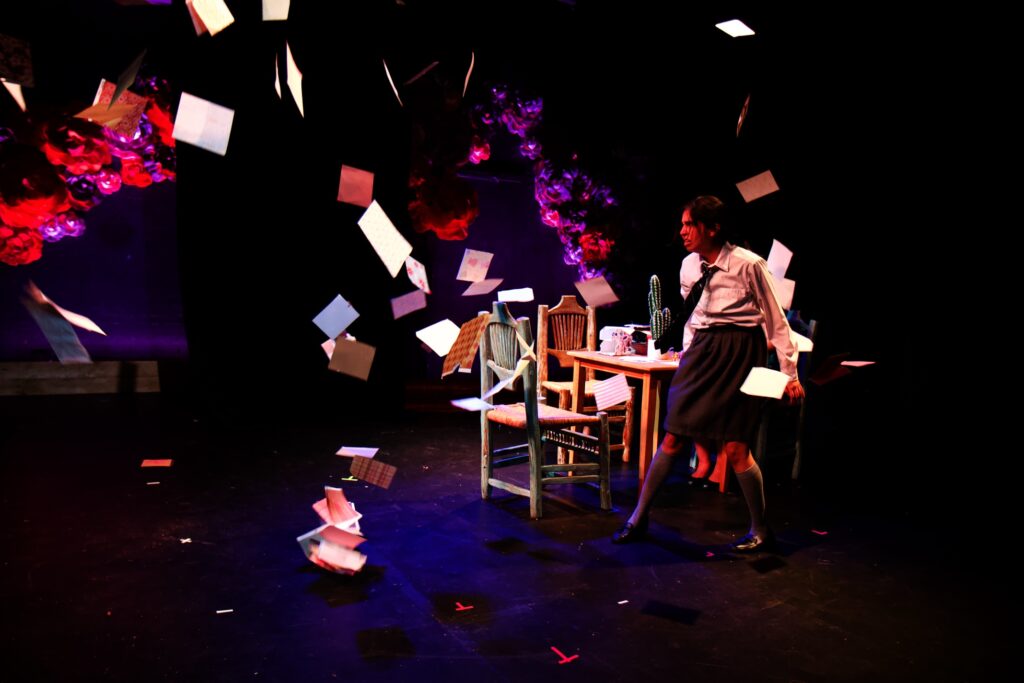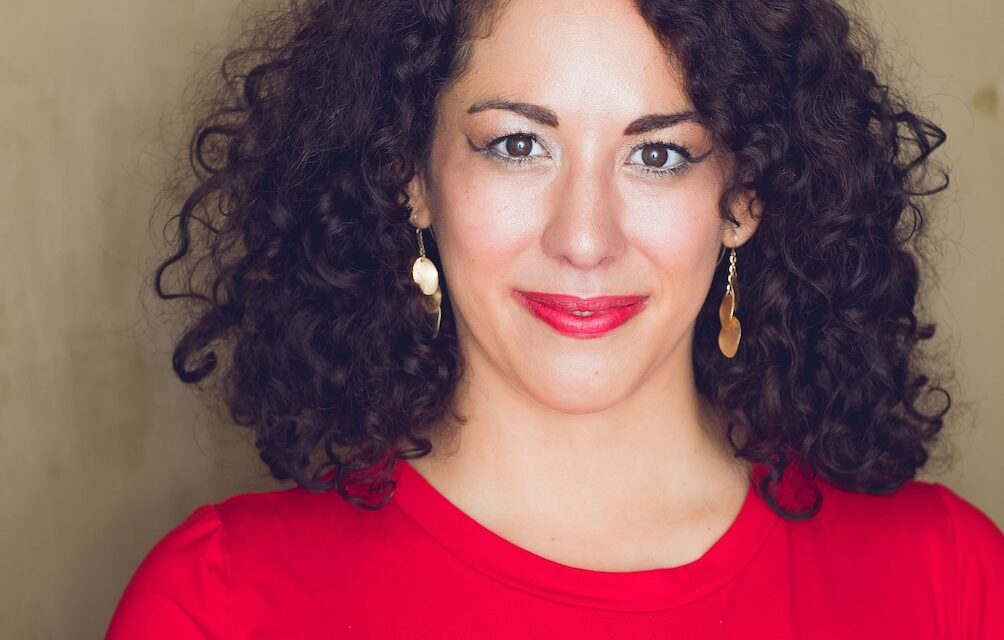by Yani Perez . . .
Mi Abuela, Queen of Nightmares by Christine Stoddard directed by Fiamma Piacentini played this September at The Tank. Christine Stoddard is a Salvadoran-American writer, director, and artist who has authored a body of work comprised of books, films, plays, visual art, and digital media.
The play tells the story of Maya, a young Salvadoran-American teenager as she navigates trauma and family mythology through magic, joy and folklore.





Photos by Mari Eimas-Dietrich
Theater Pizzazz’ Yani Perez had some questions for the playwright, Christine Stoddard and director, Fiamma Piacentini.
- What made you want to write about this topic at this time?
CS: I was going through a personal awakening uncovering some family history and confronting issues I had with my own vulnerability and identity as a woman. During this period, I learned the details of my grandmother’s death and visited my mother’s home country of El Salvador for the first time ever. This process helped me realize so much about myself and intergenerational cycles of trauma. But I also realized that these issues were not unique to myself or my family and that many of my own discoveries were more broadly Latina or even more broadly matrilineal, almost regardless of culture. Yet it takes specifics to render certain stories more universal. I knew I wanted to draw from my Salvadoran heritage and think about the poetics of surviving and healing from El Salvador’s civil war. In my case, as the daughter of an immigrant born in the U.S., it was my survival and healing from the legacy of the war, not the war itself. The war is tied to Spanish colonialism, Indigenous genocide, U.S. imperialism, immigration, refugeeship, femicide, and continuing poverty and violence. So, loosely inspired by my own life and family events, I conceived the fictional world of Maya, Mami, and Abuela. I set their home in Phoenix, AZ, where my little sibling was living. I spent a chunk of time there over the course of a couple years. In the world of this story, cycles of pain and mother-daughter relationships are revealed through the memory and fantasy of Maya’s highly creative and sarcastic mind. There is the repetition of grief and then joy used as a coping mechanism by Maya but also her mother. Jaguars, cacti, and owls are part of Maya’s imagination and colorful background to her thoughts. It was important for me to hit a variety of emotional notes in the story and not keep everything so dark and heavy, despite some tragic themes.
- Christine, I see that you’re also a poet and it shows! You use beautiful language and images in Mi Abuela, Queen of Nightmares. How does poetry influence your work?
CS: Thank you! Poetry is a lifelong love. When I was younger, most of my introduction to Spanish literature was through poetry because it was shorter and easier for me to understand as someone whose first language is English. I consider song lyrics and nursery rhymes as part of the same family as poetry. Two of the songs in the play—”De Colores” and “Los Pollitos Dicen”—are ones my mother sang to me as a child. Hearing English and Spanish at home had me think about the interplay between languages from a young age. My mother and I often filled in the linguistic gaps for each other. She became fluent in English and a U.S. citizen. Meanwhile, I committed to learning Spanish beyond colors, numbers, and favorite foods. My mother was also a fan of French, Italian, and Arabic and often had movies and songs in these languages playing at home. Even if we didn’t always have translations for media in other languages, I would pay attention to the musicality of spoken words. I owe this attentiveness to my mother’s influence. She often pointed out what French, Italian, and Arabic words were the same or similar to those in Spanish. In high school and college, I became a more serious student of poetry, not to mention other literary forms. Not all of my writings deal with heightened language like you find in “Mi Abuela.” Yet no matter the genre or form, I’m aware of different literary schools and still care deeply for finding just the right word.
- The play uses powerful symbols and rituals, what is the significance of these rituals? To you? Your heritage?
CS: Catholicism certainly influenced my perceptions of rituals growing up. I wasn’t raised Catholic, but my mother still dragged my siblings and me to Mass once in a while. She still considered herself Catholic, though she never had us baptized. She wanted us to choose our own religion. I grew up watching Anglo Mass and Hispanic Mass, depending on whether my mother wanted Mass in English or Spanish that trip. The nuances in liturgy fascinated me. Often, I would fixate on the nuances to keep myself awake during Mass, especially if that particular homily wasn’t so clever or moving. “Oh, they did that in the English Mass, but that in the Spanish Mass. Huh. OK. Interesting.” I found the idea of prayer very comforting and loved the fabulistic nature of the saints. My mother always said her prayers in Spanish and was especially devoted to St. Francis of Assisi. He was her mother’s Saint and they shared an affinity for animals. I also saw so much ritual in my mother’s cooking, especially the dishes she preserved from her native culture.
Cooking brought back happy memories and I guess curbed some of the homesickness. Quesadilla salvadoreña was my favorite treat, in part because it was so hard to find in restaurants or grocery stores where I grew up. She also made pupusas, sopa de camarones, casamiento, carne asada, yuca frita, tamales, horchata, sancocho, etc. Each step of preparation brought her a lot of joy and it touched her to see us love what she made that tasted like home. Some of these dishes she made the Salvadoran way and also the Mexican way if it existed. While some Salvadorans see Mexicans as rivals or even Aztecan conquerors, my mother taught us to be accepting. She’d say that we share Mayan ancestors. Or as one of my Indigenous editors put it even more broadly, we are all children of Turtle Island. There was also the practical point of there not being enough Latinos where we lived to focus on in-fighting. Mexi-Salvi unions are fairly common in diasporic situations for this reason. To bigots, we’re all the same. We aren’t, but that doesn’t mean we can’t celebrate commonalities while respecting differences. This is how immigrants who speak the same or similar languages and share some traditions help each other. You could say that peace-making was another one of my mother’s rituals. I know that the Jesuits and living through war planted that desire in her.
FP: Growing up in Mexico I was always fascinated and enamored by the symbolism and rituals that I saw everyday. There are a lot of rich traditions that have been passed down amongst the Mexican people for centuries, both prehispanic and colonial. Once Mexico was conquered by Spain, the colonists tried to force the indigenous people of Mexico and the rest of the Spanish colonies (including El Salvador and stretching all the way down to Chile) away from their ancient culture and beliefs and into Catholicism. What remains is a unique blending of indigenous traditions and Catholic faith. It was Christine’s idea to add the Salvadoran Women to the scene changes, and I was so excited for the opportunity to bring the mixing of those rituals to the stage: Mami’s staunch Catholic faith blended with the ancient rituals of the Mayan people. I think it is a line that many Latin Americans walk, a dichotomy that they live with everyday. I wanted to have the ancient Mayan music and rituals performed by the Salvadoran women because I do believe that even though these traditions were forced away from us, they exist within us, and it is important to keep them as part of our culture.
- The set design is simple yet powerful and symbolic. Was that your vision for the set design?
CS: I always imagined the set design being fairly sparse, with splashes of color and texture. When I directed the workshop run of the play at the Gene Frankel Theatre last year, I imagined different zones of the stage, with each room or area realized almost like an altar. There was a fair amount of breathing room between each of these zones and a big, black floor. In Fiamma’s vision for the premiere at The Tank, she took an even sparser approach and worked with set designer Rodrigo Escalante to make it possible. I think this aesthetic speaks to the touchstones of memory and living with material scarcity in new immigrant settings. It also speaks to the power behind objects we deem sacred for whatever reason. Some objects are sacred because religion tells us so. Other objects are sacred because we anoint them in our personal lives or family histories. Even an ordinary object can be electrifying. It all depends on our unique association.


Fiamma Piacentini
FP: For our run at the Tank, I was lucky enough to find Rodrigo Escalante, our Set Designer, on an online directory for BIPOC theater designers. His work was beautiful, and I saw that Rodrigo was from El Salvador. I immediately knew that I needed to have him on his project. Being of Mexican descent, it was very important to me to have Salvadorans on our team; it is very easy for all Latinos to be lumped into one group, so I wanted to make sure to have distinctly Salvadoran voices and creative direction. We had some constraints on budget and the amount of build we were allowed to do, but Rodrigo did a beautiful job of working within the parameters to create a set that I feel really added to the magical realism of the piece. The large, dusty flowers created a space that really made it feel like a memory, which is what the play is made up of, a collection of old memories.
- Tell us what you are working on next. Any new projects? Plays? Books?
CS: Oh, there are always new projects! And always to keep the momentum going for not-so-new projects! For instance, this is not the end of “Mi Abuela, Queen of Nightmares” as a stage play. I hope to get it licensed and performed at venues across the country, in addition to perhaps being involved in another run in New York City. My feature film Sirena’s Gallery, distributed by Summer Hill Entertainment, is starting to reach streaming platforms. Promotion for that project is part of my work now.My talk show Badass Lady-Folk, which started as a podcast, is now in its first season as a TV show on Manhattan Neighborhood Network. So I’m booking guests and playing with the art of conversation for each episode. My feature film Her Garden is now in post-production. As Her Garden progresses, I am pitching the filmed version of Mi Abuela, Queen of Nightmares to distributors.Speaking of pitching, the stage script Heartbreak at Tompkins Square Park and the screenplay A Teacher’s Nights are making the rounds.I am in the final stages of preparing my novel Conejita for whatever journey it may take to reach its audience. Meanwhile, for my Master’s thesis at Columbia University, I am in the early stages of developing my documentary about the Salvadoran diaspora living in the United States.
Featured Photo: Christine Stoddard


















